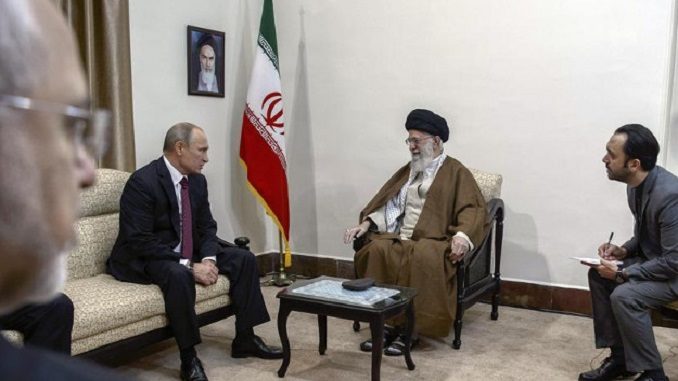
Despite the fact that Iran and Russia enjoy very close political ties at a strategic alliance level, the alliance is not reflected in trade ties, Azer News reports.
In the latest sign of warming relations between Iran and Russia, President Vladimir Putin arrived in Tehran last month to participate in a trilateral summit with Iran and Azerbaijan on regional cooperation and held meetings with Iran’s leadership to discuss ways of boosting bilateral ties between Moscow and Tehran.
According to the Iranian press, Khamenei told the visiting Russian president that the two countries should cooperate more closely to “isolate America,” stabilize Syria, and expand bilateral defense and trade ties. The supreme leader emphasized that Moscow and Tehran proved through their cooperation in Syria that they “can achieve common goals under difficult circumstances.
Putin reportedly told Khamenei that Russia considers Iran a “strategic partner” and stressed that Moscow is keen to further expand economic, defense and diplomatic relations with Tehran.
“We showed to the world that we can resolve key issues in our region without the need for transregional countries,” the Iranian media quoted Putin as saying.
Furthermore, despite close cooperation in Syria, a history of distrust and divergence of interests are likely to continue to hinder the two countries’ tactical cooperation from translating into a strategic relationship. Iranian media often questions Moscow’s sincerity. When officials of the two countries announced the start of their negotiation over a $10-billion arms deal, a number of Iranian parliamentarians, analysts and media outlets expressed doubt – citing that Moscow delayed the delivery of S-300 missiles for many years.
Reformists in Iran are particularly suspicious of Russia and often point out that Moscow sided with Washington to punish Tehran economically when it suited Russia’s interests. However, as the Trump administration is ratcheting up pressure on Iran, there seems to be less resistance in Iran to moving closer to Russia and relying on Moscow to minimize the impact of new U.S. sanctions.
But the sides have also failed so far to boost the volume of the trade, as obstacles still exist. After the tension between Moscow and West escalated in recent years, there was a big opportunity for Iranians to pave their way to Russia’s food market, but the expectations did not materialize due to various obstacles.
Experts believe that shortcomings in banking ties, transportation issues, lack of proper marketing and unawareness of the Russian market’s capacities, different hygienic standards applied in the two countries and low quality of Iranian products, visa complications, the tendency to consume European goods by Russians and a lack of reciprocal trust between merchants of the two sides are among the main obstacles ahead of Iranian exporters to find a foothold in Russian market.
Some Iranian businessmen are satisfied that the trade relations, which have been hampered for many years, will not be established overnight. Earlier, Secretary General of Iran’s Aquatics Producers’ Association Ali Akbar Khodaei said that the export of aquatics to Russia is a long process and needs much ground preparation.
Despite the fact that Iran’s exports to Russia did not witness big changes in these years, the country’s imports have experienced significant fluctuations. Russia’s exports to Iran jumped by 115 percent to $1,632 million in the fiscal year of 2012/2013, when the intensified sanctions hit Iran’s economy. However the figure decreased by 58 percent in the succeeding year and did not revive till the removal of international sanctions in 2016.
Despite the fact that Russia’s exports to Iran flourished during the first year following the removal of the sanctions, the latest statistics by Iran’s Customs administration indicate that the trend has changed downward again.
Russia exported $419 million worth of goods to Iran in the first seven months of the current fiscal year (started March 20, 2017), 63 percent less year-on-year. However, the volume of exports was 909,000 tons, 1 percent more compared to the seven-month period of the preceding year. This indicates that the Russia has exported more goods but with less value to the Islamic Republic in the period.
On the other hand, Iran’s exports to Russia accounted to $228 million in the first half of 2017, 36 percent more year-on-year, a sign that Iran is gradually increasing its share from Russia’s food market.
